Travel
Visit Korea
Logistical and Cultural Tips for Travelers to South Korea
Information ahead of travel
- Tipping Culture
– No Tipping: In South Korea, tipping is not expected in restaurants, taxis, or other service industries. Service charges are usually included in the bill.
- Plug Type and Voltage
– Electrical Outlets: South Korea uses Type C and Type F plugs (same as most of Europe – see picture).
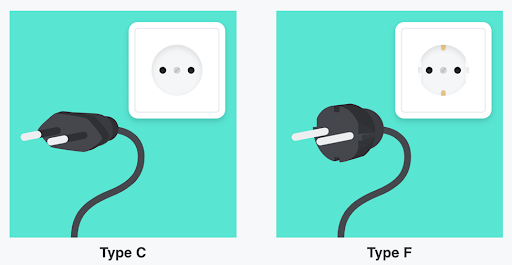
– Voltage: The standard voltage is 220V with a frequency of 60Hz. You may need a plug adapter and possibly a voltage converter.
3. Currency
South Korean Won (KRW):Credit cards are widely accepted, but it’s a good idea to carry some cash, especially for smaller purchases. Most notably, you will need cash to buy single tickets or top up your transportation card for public transport.
4. Language
-Basic Korean Phrases: English is understood in many tourist areas, but it’s helpful to learn a few basics:
– Hello = 안녕하세요 (Annyeonghaseyo)
– Thank you = 감사합니다 (Gamsahamnida)
– Translation Apps: Apps like Google Translate or Papago can assist with language barriers.
5. Public Transportation
– Efficient Transit: South Korea has excellent public transport, including buses, subways, and trains. We recommend getting a T-money card for convenience. These can be purchased at every major convenience store, or in subway stations themselves. You can choose how much to load onto it, just like a Presto Card. If you decide to get a Korean sim card for your stay, some providers offer a transportation card for free, although you have to top it up yourself (you can do this on arrival at the airport).
– Subway Etiquette: Keep quiet and avoid phone calls while riding. Priority seating is reserved for elderly, pregnant, or disabled passengers. Metro trains can be packed during rush hour. Either accept being packed like sardines or avoid the metro around this time of day.
– Directions and Ubers: While Google maps function decently well in Seoul, especially for things like finding the appropriate metro schedules and lines, the best navigation app is called Naver. It is similar to google maps and uber rolled into one, with much better results and the ability to order taxis very easily. That being said, Uber is also available (Called UT [Uber-Taxi] in Korea). Don’t be surprised if your Uber is a taxicab rather than a private vehicle. Finally, you pay when you get to your destination via credit card or T-Money card, rather than prior to the trip in the app.
6. Driving
– International Driving Permit Required: If you plan to rent a car, you’ll need an International Driving Permit).
– Traffic Rules: Stick to crosswalks—jaywalking is discouraged!
7. Water Safety
– Tap Water: It’s safe to drink, but locals often prefer bottled or filtered water, which is readily available.
8. Dining Etiquette
– Chopsticks: Koreans use metal chopsticks, and it’s considered rude to stick them upright in a bowl of rice, as this can be a symbol for the dead. It is very unlikely someone would actually care, but good to know for cultural awareness.
– Shared Dishes: Many meals are shared family-style with side dishes (banchan). It is not common to order individual dishes at a Korean restaurant like you would in Sweden or other European countries.
– Bill Splitting: Splitting the bill has become more common in recent years in Korea, but it is still not as common or readily accepted as it is in many western countries. When eating out with a group, it may be good to have some cash on hand to cover your own portion or keep track of expenses and reimburse each other.
– No Tipping at Restaurants: As mentioned earlier, tipping isn’t common in restaurants.
9. Respect for Elders
– Hierarchy and Politeness: South Korean culture values respect for elders. When speaking to or offering something to an elder, use polite language and bow slightly.
10. Shoes Off Indoors
– Shoes Off: It’s customary to remove shoes when entering homes or traditional accommodations like hanoks.
11. Wi-Fi and SIM Cards
– Wi-Fi Access South Korea has excellent Wi-Fi coverage. You can rent a portable Wi-Fi router or buy a SIM card at the airport.
– Local/E SIM Cards: For mobile access, consider getting a tourist SIM card at the airport (Kiosks are near exit 2). e-Sims are also great. I personal like to use Airolo, here is a short video explaining how to use it: https://www.youtube.com/watch?v=6RNFrMAVVjY&ab_channel=Airalo (Apple)
https://www.youtube.com/watch?v=mLN04EQEPZI&ab_channel=Airalo (Android)
12. Time Zone
– Korea Standard Time (KST): South Korea operates on KST (GMT+9) with no daylight savings time. 1 pm summertime in Sweden/GMT+1 is 8 pm the same day in Korea.
13. Gifting and Drinking Etiquette
– Two Hands Rule: When giving or receiving something, it’s polite to use both hands as a sign of respect.
– Consideration for Elders: When drinking with others, it’s polite to pour drinks for others rather than yourself. You should also hold your glass with both hands when receiving a drink from someone older.
– Turning Away: If you’re drinking with elders, it’s respectful to turn your head to the side, away from the oldest person, when taking a sip.
– Refills: If someone’s glass is empty, it’s customary to offer to refill it. Usually, the younger person offers to fill the glass of the elder person.
14. Emergency Numbers
– Emergency Services: For emergencies, dial 119 for medical help or fire services, and 112 for the police.
– Swedish Embassy: Make sure to have the Swedish embassy’s contact details in case of need. Swedish citizens can download and register with the app “UD Resklar” to provide contact information to the Swedish embassy in case of emergency.
Swedish Embassy in South Korea
- Address: Danam Building, 8th Fl. 10
Sowol-ro, Jung-gu
Seoul 04527, South Korea - Phone: +82 2 3703-3700
- Email: ambassaden.seoul@gov.se
- Website: Swedish Embassy in South Korea
15. Shopping and Tax Refunds
– Tax Refunds: Look for “Tax-Free” shops and be sure to claim your refund at the airport before your departure.
16. Passport Validity
– Passports: Be sure that your passport is valid beyond your stay in South Korea.
List of popular Korean Food 🥘
Other recommended places to visit in South Korea
Busan
South Korea’s second-largest city, is renowned for its beaches, mountains, and bustling port culture. Haeundae Beach, Gamcheon Culture Village, and the ancient Beomeosa Temple are top attractions. Busan combines a laid-back seaside atmosphere with cosmopolitan flair. Though further from Seoul, it’s easily reached via KTX.
Destinations for history and culture
Jeonju
Jeonju, the birthplace of Korea’s iconic dish bibimbap, is a city steeped in tradition and charm. The highlight is the Jeonju Hanok Village, home to over 700 traditional Korean houses where visitors can explore tea houses, artisan workshops, and museums. Easily accessible from Seoul by KTX train, the city’s vibrant food scene and strong cultural roots make it a must-visit spot.
Gyeongju
Often referred to as “the museum without walls,” Gyeongju was the ancient capital of the Silla Kingdom(57 BC- 935 AC). Key attractions include Bulguksa Temple, the Seokguram Grotto, and the UNESCO-listed Gyeongju Historic Areas, including the ancient tombs at Daereungwon. Despite being further from Seoul, it is well-connected via KTX and worth the trip for its rich historical and cultural offerings. Gyeongju’s serene yet majestic ambiance captures the essence of Korea’s ancient past.
Gongju
Once the capital of the Baekje Kingdom (18 BC-660 AC), Gongju is a compact but historically significant city. Must-see sites include the Gongju National Museum, Gongsanseong Fortress, Royal Tomb of King Muryeong, and the Magoksa Temple. Gongju exudes a tranquil charm, with fewer crowds than other historical cities. Located near Daejeon, it is an easy day trip by bus or car. Gongju is ideal for those seeking a quiet exploration of Korea’s Baekje heritage.
Suwon Hwaseong Fortress
Suwon, famous for its UNESCO World Heritage-listed Hwaseong Fortress, is a city that blends modernity with history. Visitors can walk along the fortress walls, explore the Hwaseong Haenggung Palace, and enjoy the city’s vibrant markets. Another advantage is that it’s conveniently located less than an hour from Seoul by subway.
Andong
Known as the cultural capital of Korea, Andong offers a glimpse into the country’s Confucian heritage. The UNESCO-listed Hahoe Folk Village is a standout, where visitors can experience traditional houses and mask dances. Other attractions include the Andong Soju Museum and Dosan Seowon Confucian Academy. Accessible by train or bus from Seoul and a shuttle bus to the Folk Village runs from the train station every hour.
Destinations with beautiful natural surroundings
Suncheon
Suncheon, the “ecological capital” of South Korea, is celebrated for its stunning wetlands and gardens. The Suncheon Bay Wetland Reserve, Suncheonman National Garden, and the Waon Beach are must-visits for nature lovers. The city also offers access to Naganeupseong Folk Village, a preserved town of Joseon Dynasty, and Seonamsa Temple that bears 1,000 years of history. While it’s slightly off the beaten path from Seoul, you can reach the city by 3 hours of train ride from Seoul. The recommended touristic spots are scattered across the city, and we do recommend renting a car to cover all the attractions as well as to make the trip worth it.
Tongyeong
Tongyeong is a picturesque coastal city famous for its stunning sea views, vibrant seafood markets, and artistic charm. As the home base of Admiral Yi Sun-sin, one of Korea’s greatest naval heroes, Tongyeong is steeped in historical significance. Visitors can explore Samdosugun Tongjeyong, the former headquarters of the Three Provinces Naval Command, where Admiral Yi devised strategies during the Imjin War. Nearby, Chungnyeolsa Shrine commemorates his legacy and sacrifices for the nation. Additionally, the Tongyeong Cable Car and Dongpirang Mural Village offer panoramic views and artistic charm. Unfortunately, Tongyeong is not accessible by train, so a bus or a rental car is advised.
Haenam
Haenam, located at the southernmost tip of the Korean Peninsula, is a tranquil region known for its breathtaking natural landscapes and historical significance. Key attractions include Ttangkkeut Village, the “Land’s End” of Korea, where visitors can witness stunning ocean views, and Daeheungsa Temple, a serene Buddhist site nestled in the mountains. For a more secluded experience, visitors can hike to Dosolam Hermitage, a small, picturesque retreat perched on a rocky hillside, offering peaceful solitude and panoramic views. Haenam also offers historical insights through sites like the birthplace of renowned scholar Go Gwang-sun and traces of Korea’s Confucian heritage. Though Haenam is more remote and requires a longer journey from Seoul(5 hrs by bus), it is accessible via bus or train through nearby cities like Mokpo.
Additional tips:
- I recommend the official Korea Tourism Organization website (www.english.visitkorea.or.kr) to plan your trip.
- Download naver map app for more up-to-date and accurate navigation and location system, and kakao T app for calling cabs.
- Use the Korail website for booking trains online.
Seoul
Seoul is the capital and largest city of South Korea hosting about 9.6 million residents. The broader Seoul Metropolitan Area, encompassing Seoul, Gyeonggi Province and Incheon hosts nearly 25 million people and is the world’s sixth largest metropolitan economy. Discoveries of mankind have been found habitating near the Han river since the Paleolithic Age (8,000 BC), and it has served as a capital to a kingdom (Baekje, 18 BC-660 AC), a dynasty (Joseon, 1392-1910), and a republic (Republic of Korea, 1948-present) since then. In the early 20th century, Seoul was occupied by the Japanese Empire, temporarily renamed “Gyeongseong” (“Keijō” in Japanese). The Korean War in 1950-1953 brought fierce battles, with Seoul changing hands four times and leaving the city mostly in ruins. Nevertheless, the city has since undergone significant economic and cultural growth, attracting tens of millions of tourists every year.
1. Travel back in time at the Gyeongbokgung Royal Palace

2. Discover Changdeokgung and the Secret Garden

While Gyeongbokgung was built to maximize a sense of order and tension by aligning the layout along the north-south axis, visually emphasizing the authority of the royal family and the dignity of Confucian principle, Changdeokgung is renowned for its harmony with nature, especially the enchanting Secret Garden(highly recommended). Both being a UNESCO World Heritage Site, the secluded garden boasts serene pavilions, lotus ponds, and lush greenery, making it a peaceful retreat. Guided tours are required to explore the Secret Garden***. The palace opens 9:00-18:00 (the entrance closes at 17:00) and is closed on Mondays. The English guided tour is provided at 10:15 and 13:15 on opening days.
***Guided tour reservations are on a first-come, first-served basis from 10 am, six days before the desired viewing date until the day before (Guided tours in English: 10:30, 11:30, 14:30, and 15:30). Please contact Ji Yeon as foreign-issued credit cards cannot be used on the reservation website. Since the Secret Garden route passes through the palace area, you must also reserve or purchase a ticket for palace admission separately.
There are five palaces within the Seoul perimeter. The palaces have “same same but different” character and ambiences, so you can check out there places besides the two that we recommend. In my opinion, Deoksugung stands out from the rest as it has a touch of modern taste thanks to Gojong (second to last king of Korea, reigned from 1864-1895) who favored newly introduced cultures at the time.

3. Stroll around the Bukchon Hanok Village
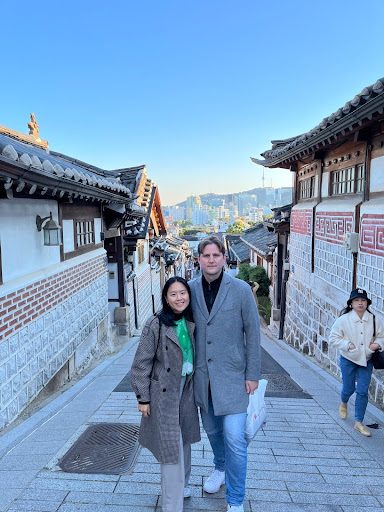
Imagine what it’s like to walk through a rich neighborhood of Seoul in the 17th century by wandering through the charming alleys of Bukchon Hanok Village, where traditional Korean houses (called “Hanok” in Korean) are beautifully preserved amidst the modern cityscape. Perfect for photography and cultural immersion, the area is also dotted with quaint tea houses, craft shops, bakeries, and art galleries. Please keep quiet and don’t ring the bells, try to enter the houses, or litter. People are living inside. To protect resident’s rights and privacy, the visiting hours have been imposed 10:00-17:00.
4. Shop for souvenirs in Insadong
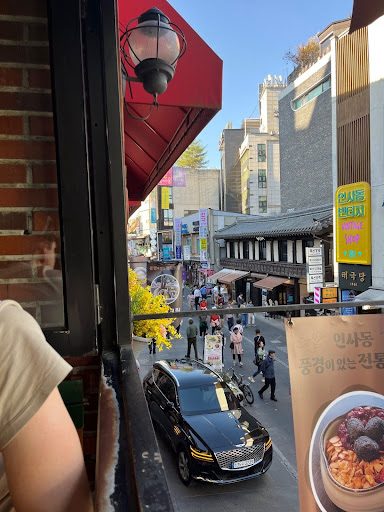
A charming blend of tradition and modernity, Insadong is the perfect place to shop Korean traditional souvenirs. Stroll through its lively streets lined with art galleries, antique shops, and traditional tea houses. Don’t miss the chance to try Korean crafts like calligraphy or enjoy a nice view of the hustle-bustle street by sitting at a window seat of a second or third storey cafe.
5. Climb the Seoul N Tower
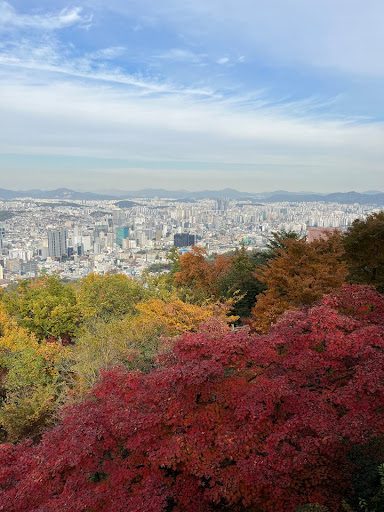
Perched atop Namsan Mountain, the iconic Seoul N Tower offers panoramic views of the city, especially stunning at sunset or night. Couples flock here to attach “love locks” on the fences. For those with height fears, do not worry—you will get a stunning view of Seoul from the mountain top without having to get on top of the observatory deck of the tower. Accessible via a cable car, hike, or shuttle bus (#01A or #01B from Chungmuro metro station or Dongguk Univ. metro station).
6. Dig into the country’s long history and culture at the National Museum of Korea

If you have to choose one museum to visit in Korea, this is it. Discover Korea’s rich history and culture at the National Museum of Korea, one of Asia’s largest museums. Its extensive collection includes ancient artifacts, Buddhist art, and Joseon-era treasures. Be ready to spend at least a day here as it’s massive (I’ve been here 3 times and I still quite haven’t managed to finish – Ji Yeon’s comment). The museum regularly hosts rotating exhibitions and is closed on Mondays.
7. Jongmyo Shrine

Jongmyo Shrine, a UNESCO World Heritage Site, is a sacred place dedicated to the spirits of Joseon kings and queens. Predicated upon Confucianism, the Lee family, the heir of the royal family of Joseon Dynasty, still performs “Jesa” (paying a tribute to the departed ancestors) every year in this shrine. And guess when this day is—The first Sunday of May!! For those who will already be in Seoul on May 4, and want to experience the authentic “exoticness”, I recommend you a visit. For other days, guided tours are available, and the shrine is closed on Tuesdays.
8. Myeongdong
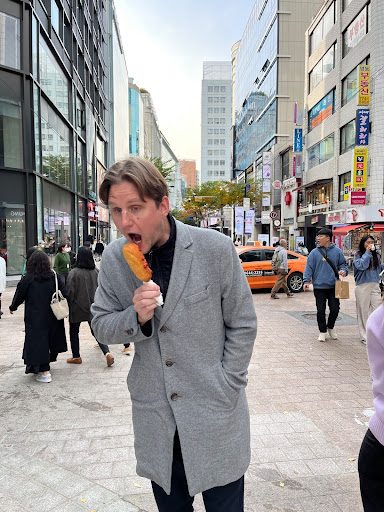
Shopaholics and food lovers rejoice! Myeongdong is a bustling hub of trendy boutiques (especially cosmetics), global brands, and famous Korean street food. Try delicacies like tteokbokki (spicey rice cake that usually comes with fish cake – Hannes eats around the fish cake though), fish cake soup, twist potato, bungeoppang (fish-shaped bun with sweet red bean filling), coin-shaped bun with cheese, rice cake with fruits, grilled squid, and various types of skewers, while indulging in skincare and cosmetics shopping. Crowded yet vibrant, it’s a sensory delig
Made famous globally by Psy’s “Gangnam Style,” this upscale district is synonymous with luxury shopping, fine dining, and nightlife. If you don’t feel like shopping for anything expensive, you can also take the stairs down to the metro and there will be a whole new shopping aisle in front of you. In Korea, you can easily see shopping centres inside the metro station, and this can continue forever. Be aware though, not necessarily always, the price can match the quality. In the vicinity, you can visit the COEX Mall, explore the fashion-trendy Garosugil street, or unwind at Bongeunsa Temple (a tip – you have a high chance of finding better temples in nature, if you plan to visit other cities) for a mix of modern and traditional experiences.

A youthful and artsy neighborhood, Hongdae is famed for its indie music scene, street performances, and quirky cafes. It’s the perfect spot for nightlife, shopping at unique boutiques, or enjoying themed cafes. Weekends bring lively flea
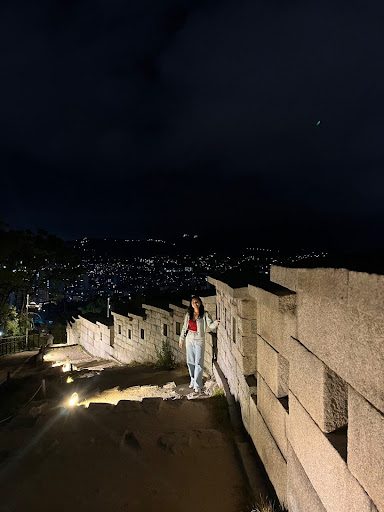
Now you’ve reached my favorite spot in Seoul. Naksan park offers a tranquil escape with scenic views of Seoul’s skyline and the iconic city wall. One of the best stroll areas among locals and tourists, the park is particularly stunning during the night and cherry blossom season. My recommended trail starts at Dongdaemun metro station around sunset. Begin your walk from Heunginjimun park (the two parks are connected by the fortress) along the Naksan Fortress. It’s quite an uphill walk, but the effort will pay off when you reach the top and take in the stunning view from the park. When you arrive at the observatories, you will have the view not only of the Seoul city center but also its outskirts. Another strong recommendation is a cafe called “Gaeppul” located just before reaching the Naksan Park. Order a draft beer and sit out on the balcony facing the most dazzling view of Seoul. This must be the highlight of your trip to Seoul.

A fusion of traditional and contemporary art, the Leeum Museum features works ranging from ancient ceramics to modern masterpieces. Its striking architecture enhances the experience, making it a must-visit for art lovers. The museum is typically closed on Mondays.
13. Shop for skincare products in Olive Young
We finally arrive at the highlight of this section. Now, I know a lot of you are interested in Korean skincare products, but a disclaimer. I am no guru in this domain. I will give you my meager two cents.
In Myeongdong,
- Please don’t buy products before checking online if it’s really a Korean brand (and a legit popular one. There are lots of “pretending to be Korean products” in Myeongdong).
Check for the price online before purchasing. Obviously, buying online can be much cheaper as third parties make business by underselling. But at least make sure the suggested price is actually a bargain.
In Olive Young,
- If you don’t want to rack your brains out, then just go to Olive Young. It’s the Korean version of Sephora and all products sold here are fixed price with legit Korean brands. Many are on promotion and have thorough descriptions categorized by product, brand, skintone, skin type, and so forth. Myeongdong branch is known to have staff who speak 15 different languages, but I would not recommend this specific branch because the line and waiting time is absurdly long, always short on stock, and staff is completely occupied.
- One of the bigger branches are in Gangnam, and Hongdae, but honestly, the franchise outnumbers metro stops, so you won’t miss it.
- When planning to go to Olive Young, please make a list of products you want to buy, or at least the kinds you want to get (check out their website), or else you may find yourself coming out the door without a single intended product in your hands but hundreds of bucks spent.
- Must items I get when I visit Korea (starting from the priority): facial mask, essence, lotion, cleansing oil and cleansing foam, eyeliner, blusher, hair treatment pack, sunscreen (and all others as long as the space allows).
- Not the most trendy, but I am listing some brands (starting from my recent purchases) I use based on my definition of cheap and luxury.
- Cheap cosmetic brands: rom&nd, peripera, too cool for school, banila co., clio, etude house, etc.
- Cheap skincare brands: manyo, laneige, torriden, numbuzin, isoi, innisfree, CNP, mediheal, belif, mamonde, skinfood, primera, hanyul, tonomoly, etc.
- High end cosmetic/skincare brands: hera, ohui, sum37, sulwhasoo, sooryehan, danahan, iope, etc.
Recommended areas to stay in Seoul
Insadong, Bukchon Hanok village (near Anguk Station, metro line 3):You are within walking distance of all the historic parts of Seoul. Hassle free from the commuting crowd which is a nightmare, and you are located relatively in the center of Seoul, giving you good access to tour sites. Another plus, if you are a vegetarian, this area is the place to find vegetarian Korean restaurants. The only downside is that the buildings may be old depending on what you book and there are not many eateries at night.
Myeongdong: If you want to be treated as a tourist, there can not be a better place. You are at the heart of tourism in Myeongdong. Things will be written in English, people will understand if you don’t speak a word of Korean, tourist-targeted activities and food will be at your feet. The nightlife is extremely vibrant in Myeongdong, so if you want tranquility, this is not the place for you. Also, there are surprisingly not many vegetarian options in this area.
Itaewon: This is the international hood of Seoul. You can wake up to the sound of adhan (the muslim call for prayers), get authentic Indonesian food, and enjoy a nice Italian coffee. It has a great chill vibe with a great view of the Namsan and is close to many museums such as the National Museum of Korea, Leeum art museum and War memorial museum. The good and bad side: it’s located on a mountain slope, so you can tick off your workout plan on a daily basis.
Gangnam: You can have everything here. From the feel of the metropolitan vibe of Korea, full immersion into the K-beauty, to the never-ending nightlife. Gangnam offers from skyscrapers, cosmetic shops, hair salons, to board game rooms, arcades, and escape rooms. As long as you have the physicality to cut through the overwhelming typhoon of the commuting crowd, and a fat wallet to pay for slightly overpriced meals, this is a great place to enjoy your stay.
Hongdae: This area is a hot spot for the young, especially those who are interested in K-culture(e.g. art, music, fashion and dancing)—lively nightlife, great bars and restaurants, kitschy clothing stores, and karaokes. But be advised, it is distanced from the major tourist sites. The palaces can take up to 40 mins by metro and an hour to Gangnam. This critical reason has left this place the only location where Hannes and I haven’t stayed during our trip to Korea.
Daejeon
Daejeon is located in the center of South Korea, and thus is known for its well-connected transportation, science & IT infrastructure, and education. For example, the research and development district called “Daedeok Science Complex/Daedeok Innopolis” is located in the Yuseong-gu district in Daejeon housing over 20 major research institutes and over 40 corporate research centers. For this reason, Daejeon held an international exposition in 1993 under the title of “The Challenge of a New Road of Development”. However, contrary to it being a nice residential city, it is hardly known for its tourism. With that in mind, some of the places to visit in Daejeon are:
1. Daejeon Expo Science park
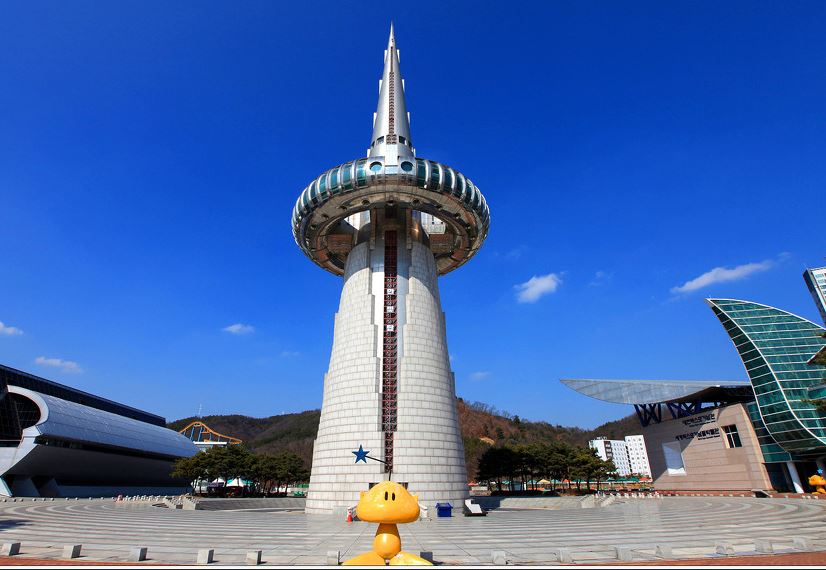
You can visit the EXPO Hanbit Tower, the EXPO bridge and the exhibition museum to know more about the historical event.
2. Have a pastry at the famous Sungsimdang bakery
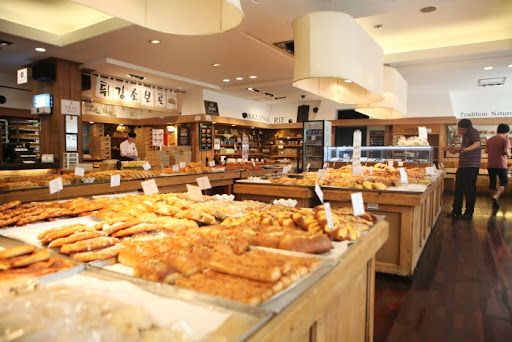
One of the oldest bakeries in Daejeon and it has become extremely famous nationwide in the past couple of years. The experience is quite hectic, and once inside you may ask yourself why you – a person with free will – would ever go through such a hellish, stressful thing. But when you see the prices and try the pastries after leaving the store you will quickly realize it was all worth it (if you’ve successfully avoided the sausage pastries – Hannes’ comment). To avoid the crowd, be advised to avoid the main store and instead visit the DCC branch and the Lotte branch, both of which are located inside two different department stores.
3. Relax at the Yuseong hot spring public bath houses
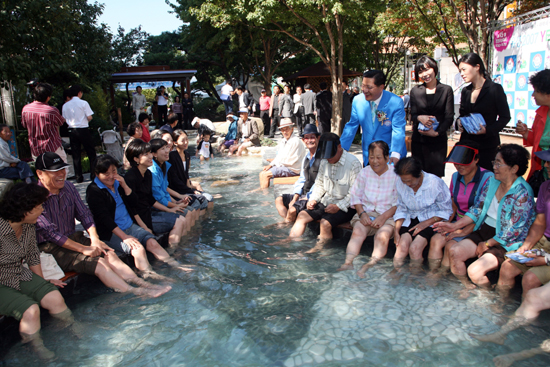
Public bath houses are a big thing in Korea, but even more so in Daejeon thanks to its natural hot springs. It smooths your skin through various minerals contained in the water. There are three different ways to experience the hot spring in Yuseong district.
- Going to “Mogyoktang” (recommend the facility at Kyeryong Spatel, 계룡스파텔 대온천탕: There are usually two different types of public baths. One is called “Mogyoktang” or “Sauna” (used interchangeably) and is just for a bath while the other is called “jjimjilbang” which is for both taking baths and enjoying additional activities such as eating, relaxing and sleeping. Depending on the type, location and size, the price shifts between 7,000 krw and 12,000 krw. Baths are separated by gender and typically have hot tubs, showers, wet saunas and massage tables.
For the brave, I highly recommend you try a message. “Massages” in the context of bath houses in Korea mean rather to exfoliate the dead skin. They scrub ALL parts of your body, obviously naked, except for your face and hair. I would advise you to shy away from it if your skin is sensitive. It costs an extra 25,000 krw (19 USD) more or less. It can feel weird when trying for the first time, but it is very refreshing after (FYI, Hannes tried it and he quite liked it).Couple of points to be aware:
-Everyone needs to be COMPLETELY naked when going into the bath. This also means you will share the big bathtubs and the sauna rooms with total strangers, naked. It goes without saying, you need to be naked when the masseur/masseuse scrubs you.
-Also, don’t forget to take a shower before going into hot/cold tubs (of course, you will have to take one before coming out as well). This is to maintain public hygiene when using facilities commonly.
-Lastly, you are not allowed to take your phones inside “Mogyoktang” where everyone is naked. The phones are allowed only in the changing area.
- Going to “Jjimjilbang” (recommend 유성온천불가마사우나 (adjacent to the designated hotels): Jjimjilbang is a complex that has several floors of which one contains “Mogyoktang/Sauna”. After you clean and change (clothes are provided), you can move to the common area (unisex) where a restaurant/snack bar, ondol-heated floor for lounging and sleeping, saunas, and wide-screen TVs are offered. Some of these services such as food and drinks will be charged additionally but at an affordable cost. Many of the sleeping rooms have themes or elements to them. Also, it has rooms with different temperatures to suit guests’ preferred relaxing temperatures. Walls can be decorated with woods, minerals, crystals, stones, and metals that have traditional Korean medicinal purposes which make the ambient mood and smell more natural.
- Yuseong outdoor foot spa: No need to pay and no need to be naked. If you want a short and simple experience, you are welcomed to visit the free, open all-year around foot spa between 7am to 11pm. You still need to use it with strangers but it’s only your legs that need to be naked. Don’t forget to bring a towel to dry off your feet after.
4. Walk around Uam historical park
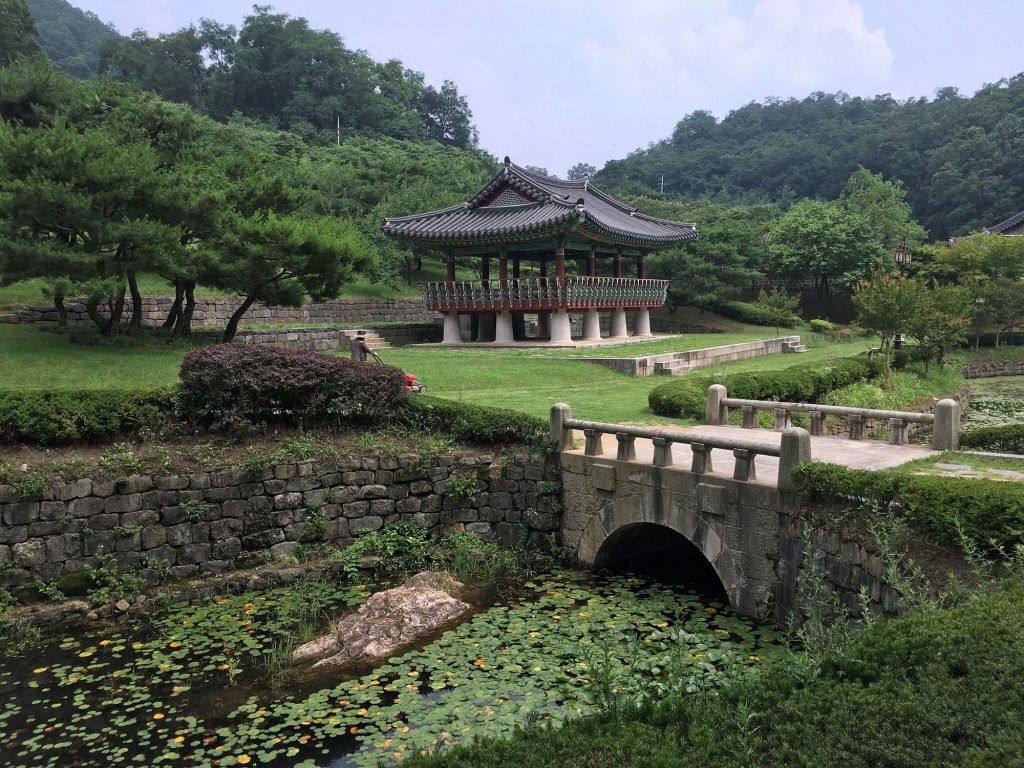
This park is built around the original house of the renowned Confucian scholar, “Song Si-Yeol’ (1607-1689), during the Joseon dynasty. Scholar Song Si-Yeol (whose pen name was Uam) was a politician, philosopher, writer and a scholar who strived to establish social rules and justice in the aftermath of the Second Manchu invasion of Korea (Joseon at the time). Siding against the toadyism of the Josheon aristocrats to the Qing dynasty after the invasion, he advocated the autonomy of Joseon and the dismantlement of the Qing dynasty through his research and educational activities based on Confucian. The structures of the buildings and the surrounding park beautifully captures the typical traditional Korean gardening, demonstrating the unharming harmony of the garden and nature. Similar sights around Korea usually charge a measly buck or two but this place is free to visit.
5. Take in the view of Daejeon from Daedong Sky Park
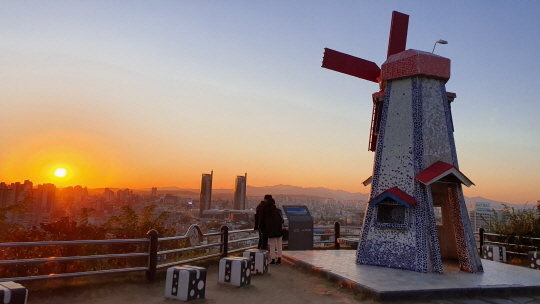
The park was formed as part of the Rainbow Project in December 2009, a restoration project of the older neighborhoods in the city. The village was first formed when refugees of the Korean War settled here. Follow the winding narrow alleyways and you can still get a glimpse of wounds of the past through the old buildings clustered together with barely space in between. Thanks to many local artists and people of the neighborhood who participated and personally decorated their home, now it has become Daejeon’s iconic mural village, marked with a giant windmill on top of the hill located 127 meters above the sea level. Visitors can see an amazing panoramic view (especially an incredible sunset view) of the city as well as relax at one of the many benches and pagodas. While walking up the mural village that connects to the Sky Park, take a break at a coffee shop called “Five Percent” which offers a magnificent view from inside. Be aware though, coffee includes the price for the view.
6. Visit at Gyeryongsan Gapsa Temple/Gyeryongsan Mountain Daedong Sky Park
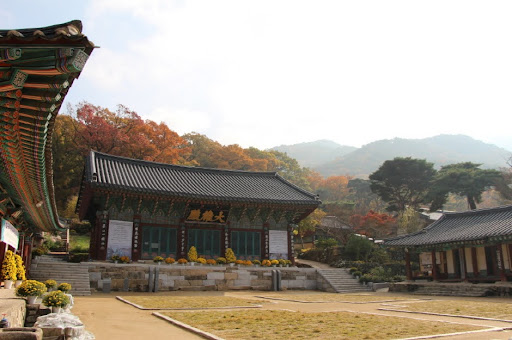
Buddhism has long been one of the most predominant religions in Korea. They are usually located away from the city center and close to nature due to its doctrine. There are bigger and flashier temples throughout Korea, however if you want to visit an unassuming temple and take a leisurely stroll inside the perimeter of Daejeon, this is the biggest one it has. It takes about 20 minutes to walk from the public bus stop to the temple, so be ready for an easy walk with a nice breeze. The walk from the bus stop to the temple would not require much strife for most people, but for those who would like to continue the walk and hike up to one of the mountain summits, be prepared in terms of your outfit, water and physical strength because it will be a steep climb until the first peak (Sambul bong) which is located at 775m altitude.
Other recommended areas at the outskirts of Daejeon where you need a car to drive:
- Aquatic Botanical Garden: (255 Bangasil-gil, Gunbuk-myeon, Okcheon-gun,Chungcheongbuk-do): beautiful garden in harmony with lake Daecheong
- Sosolu cafe: (440 Baramjae-ro, Geumnam-myeon, Sejong-si): a hidden jem in the middle of a hill overlooking a small quaint village.


